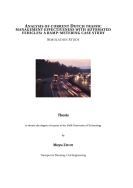Automated vehicles are conventional vehicles equipped with advanced sensors, controller and actuators. They achieve intelligent information exchange with the environment through the onboard sensing and cooperative system. vehicles are possible to have situation awareness and automatically analyze the safety and dangerous state of journeys. Finally vehicles can reach destinations following drivers’ willing. The ongoing research on intelligent vehicles is mainly about improving the safety, comfort, efficiency and provide an excellent human-car interface.
As a self-organizing system, the traffic system is quite complicated. There are many disturbance factors to lead to various traffic problems. One of the daily occurring problems is congestion on the motorway. In order to reduce congestion, Rijkswaterstaat applies various dynamic traffic management (DTM) measures to guide the traffic. It works well nowadays in conventional traffic. However, automated vehicles entered the market recently and will start to play an essential role in future traffic. The automated vehicles’ reaction to DTM measures may be different from conventional vehicles while the traffic problems still exist. Therefore, it is necessary to research the effectiveness of current Dutch traffic management in automated vehicles.
The thesis investigates the effectiveness of current Dutch DTM measures with driver assistant and partially automated vehicles. Due to the time limitation, only the ramp metering measure is researched using simulation. The main research question is ’How partial automated driving influences the performance of current Dutch dynamic traffic management system and how can this be evaluated via simulation?’. Three methods are applied, including literature review, simulation and statistical analysis. The literature part reviews levels of automation, various longitudinal and lateral vehicle motion models, which are chosen and modified in the simulation. Many ramp metering algorithms are also introduced in the literature review. The ramp metering controller in the simulation follows RWS algorithm. Besides, the motorway demand and the penetration rate of level 1 and 2 vehicles are two input of the simulation.
From the simulation results, it can be concluded that level 2 automation, consisting of daptive Cruise Control (ACC) and Lane Change Assistance (LCA), brings a negative impact on the motorway capacity. The ramp metering measure remains efficient if the penetration rate of level 2 vehicles is low. However, when the capacity reduces to the critical flow set up in the ramp metering controller, it loses its efficiency. The parameters in the ramp metering controller therefore, require an update. For further research, it is recommended to simulate the same scenarios with different ramp metering algorithms. Since the functions of the algorithms are different, there might be other robust control algorithms for automated vehicles. Also, other partial automation systems may have a different effect on the performance of ramp metering.
